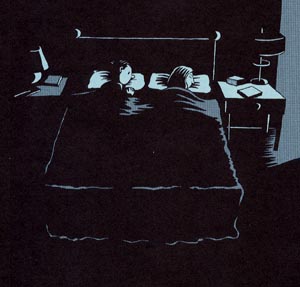 By Kevin Huizenga
By Kevin Huizenga
32 pages, two-color
Published by Fantagraphics Books and Coconino Press
Out of all the books in the “Ignatz” line, I have to admit that the one I’ve been really looking forward to is Kevin Huizenga’s Ganges. While I’m still planning on sampling the rest of the line before too long, I’ve got to say that the rest of the Ignatz line has a lot to live up to now in my mind that Ganges is here.
Glenn Ganges is just an ordinary guy. Well, that’s not entirely true. Glenn Ganges is someone who thinks. And I do mean thinks; it’s a great deal about anything and everything. As he moves through his pretty ordinary life, if there’s one thing Glenn can do it’s see what other people are taking for granted all around them.
The idea of the Ignatz line of books is an intriguing one—a series of books that are halfway between comics and graphic novels, published as an entire line in multiple languages from different publishers around the world. Reading Ganges #1, it’s pretty clear to see just why Huizenga was such a natural to have his work as part of the line-up. I’ve enjoyed his Supermonster mini-comics for years, and his appearance in Drawn and Quarterly Showcase leading to the mostly-reprint series Or Else was gratifying to see happen. That said, this is all new material from Huizenga in an oversized edition and I think it’s his strongest work to date. The book opens with “Time Travelling” and in many ways it’s a perfect representative way to introduce readers to Glenn Ganges. What starts as a simple walk to the library becomes so much more in Glenn’s mind, remembering a similar walk he took in the past and then travelling through time to that point again. It’s a great reflection on the past and what separates us between then and now.

 The rest of the book continues in a similar vein; Glenn’s imaginings of the future of a bicyclist who hurls candy wrappers out of his pockets in “The Litterer” is a fun “what if?” series of events spun through increasingly growing and larger-than-life scenarios, all while keeping the character a mystery figure whose face you never see. In many ways, it’s the funniest entry in the book, the one seeming to play towards the comedy end of the scenario than any other. While the next two stories are good, solid pieces, it’s the final entry (“Bed”) that really knocked my socks off. On the surface it’s a pretty simple idea, with Glenn going to bed and listening to his wife Wendy sleeping. It’s so much more than that, though, as Glenn begins to think about the rest of the world doing the same thing and wondering for whom it does and does not work out. It’s a beautiful story, one that could have come across with real cliche but instead feels quiet and lovely in its own way, a real ode to love and partners and the rest of the universe.
The rest of the book continues in a similar vein; Glenn’s imaginings of the future of a bicyclist who hurls candy wrappers out of his pockets in “The Litterer” is a fun “what if?” series of events spun through increasingly growing and larger-than-life scenarios, all while keeping the character a mystery figure whose face you never see. In many ways, it’s the funniest entry in the book, the one seeming to play towards the comedy end of the scenario than any other. While the next two stories are good, solid pieces, it’s the final entry (“Bed”) that really knocked my socks off. On the surface it’s a pretty simple idea, with Glenn going to bed and listening to his wife Wendy sleeping. It’s so much more than that, though, as Glenn begins to think about the rest of the world doing the same thing and wondering for whom it does and does not work out. It’s a beautiful story, one that could have come across with real cliche but instead feels quiet and lovely in its own way, a real ode to love and partners and the rest of the universe.
Huizenga’s art may look deceptively simple at a casual glance, but it’s definitely anything but. Glenn’s open face is host to a wide variety of expressions and looks, ones that bring across a great deal of the story and its emotional weight to the reader. It’s always been a nice, clean style but I’m even more impressed with his work in this new book. There’s a playfulness with the page layouts and structure at times; Glenn’s “time travelling” courtesy overlapping thoughts and events comes across clearly thanks to Huizenga’s using overlapping panels, with Glenn pushing the panel border back to step from one moment into the next. It’s the sort of storytelling that can only be done in comics, with Huizenga really utilizing all of the strengths of the art form.
 The use of the blue ink in Ganges is impressive by the different ways he integrates it into the story. In “The Litterer” Huizenga uses blue washes across the page, giving his art a very different look and texture than what I’m used to seeing. In “Bed”, it shares the page with the heavy amounts of black ink, the blue-and-black combination bringing across the visual impact of darkness in a way that a single color couldn’t have. It’s a very careful and thoughtful way of using every single tool given to Huizenga, and the result is a real reward to the reader.
The use of the blue ink in Ganges is impressive by the different ways he integrates it into the story. In “The Litterer” Huizenga uses blue washes across the page, giving his art a very different look and texture than what I’m used to seeing. In “Bed”, it shares the page with the heavy amounts of black ink, the blue-and-black combination bringing across the visual impact of darkness in a way that a single color couldn’t have. It’s a very careful and thoughtful way of using every single tool given to Huizenga, and the result is a real reward to the reader.
If the rest of the Ignatz line is as strong as Ganges (and with books already released from creators like David B., Igort, Lorenzo Mattotti I’m guessing the answer is yes) then I’m going to have a lot of great reading ahead of me. More importantly, though, regardless of the rest of the line Ganges #1 is a real success, and it is easily one one of my favorite books of the new year. With its larger trim size and a handsome slipcover, I expect this comic to be sitting on my bookshelf for years to come.
